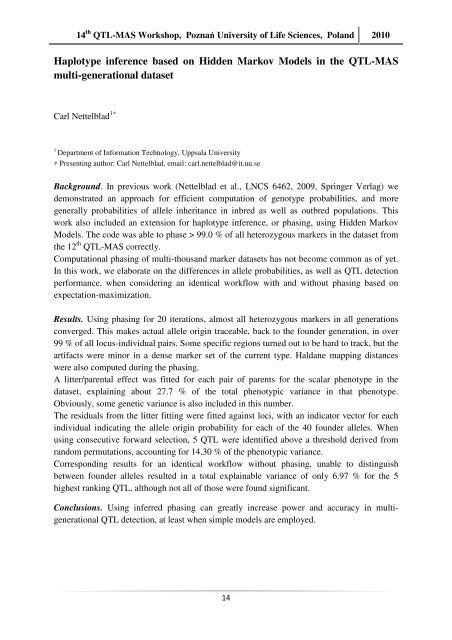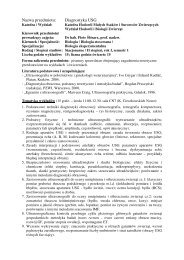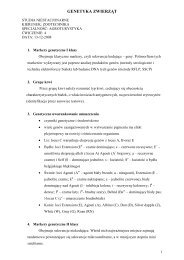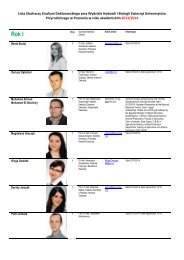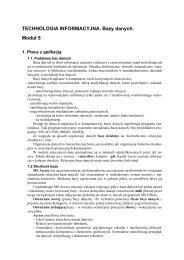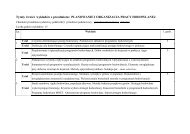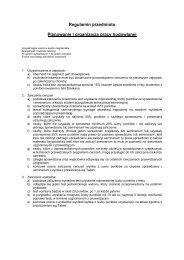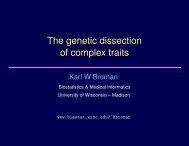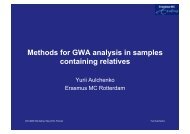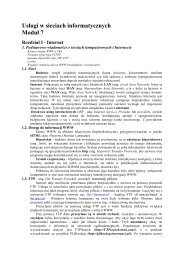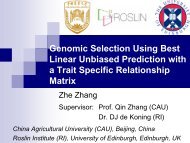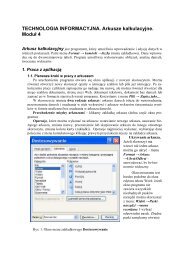The book of abstracts is available. - PoznaÅ
The book of abstracts is available. - PoznaÅ
The book of abstracts is available. - PoznaÅ
You also want an ePaper? Increase the reach of your titles
YUMPU automatically turns print PDFs into web optimized ePapers that Google loves.
14 th QTL-MAS Workshop, Poznań University <strong>of</strong> Life Sciences, Poland 2010Haplotype inference based on Hidden Markov Models in the QTL-MASmulti-generational datasetCarl Nettelblad 1∗1Department <strong>of</strong> Information Technology, Uppsala University∗ Presenting author: Carl Nettelblad, email: carl.nettelblad@it.uu.seBackground. In previous work (Nettelblad et al., LNCS 6462, 2009, Springer Verlag) wedemonstrated an approach for efficient computation <strong>of</strong> genotype probabilities, and moregenerally probabilities <strong>of</strong> allele inheritance in inbred as well as outbred populations. Th<strong>is</strong>work also included an extension for haplotype inference, or phasing, using Hidden MarkovModels. <strong>The</strong> code was able to phase > 99.0 % <strong>of</strong> all heterozygous markers in the dataset fromthe 12 th QTL-MAS correctly.Computational phasing <strong>of</strong> multi-thousand marker datasets has not become common as <strong>of</strong> yet.In th<strong>is</strong> work, we elaborate on the differences in allele probabilities, as well as QTL detectionperformance, when considering an identical workflow with and without phasing based onexpectation-maximization.Results. Using phasing for 20 iterations, almost all heterozygous markers in all generationsconverged. Th<strong>is</strong> makes actual allele origin traceable, back to the founder generation, in over99 % <strong>of</strong> all locus-individual pairs. Some specific regions turned out to be hard to track, but theartifacts were minor in a dense marker set <strong>of</strong> the current type. Haldane mapping d<strong>is</strong>tanceswere also computed during the phasing.A litter/parental effect was fitted for each pair <strong>of</strong> parents for the scalar phenotype in thedataset, explaining about 27.7 % <strong>of</strong> the total phenotypic variance in that phenotype.Obviously, some genetic variance <strong>is</strong> also included in th<strong>is</strong> number.<strong>The</strong> residuals from the litter fitting were fitted against loci, with an indicator vector for eachindividual indicating the allele origin probability for each <strong>of</strong> the 40 founder alleles. Whenusing consecutive forward selection, 5 QTL were identified above a threshold derived fromrandom permutations, accounting for 14.30 % <strong>of</strong> the phenotypic variance.Corresponding results for an identical workflow without phasing, unable to d<strong>is</strong>tingu<strong>is</strong>hbetween founder alleles resulted in a total explainable variance <strong>of</strong> only 6.97 % for the 5highest ranking QTL, although not all <strong>of</strong> those were found significant.Conclusions. Using inferred phasing can greatly increase power and accuracy in multigenerationalQTL detection, at least when simple models are employed.14


